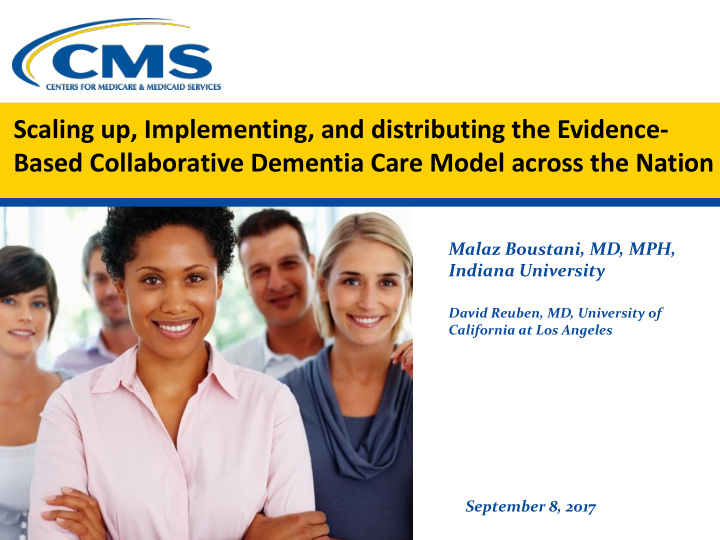



Scaling up, Implementing, and distributing the Evidence- Based Collaborative Dementia Care Model across the Nation Malaz Boustani, MD, MPH, Indiana University David Reuben, MD, University of California at Los Angeles September 8, 2017
The Problem • More than 3 million people with dementia experience cognitive, functional, behavioral and psychological disabilities • Dementia generates significant financial and emotional stress for both the person with dementia and their unpaid caregivers: • Poor quality of life for both the person with dementia, and their unpaid caregivers • Higher emergency room utilization • More frequent hospital admissions • More days in nursing home facilities • $41,000 to $56,000 yearly total cost per person Plassman et al, NeuroEpi 2007; Hurd et al, N Engl J Med 2013; Phelan et al, JAMA 2012;Callahan CM et al, JAGS 201; Alz Ass Facts & Figure 2017;
The Solution: Evidence-Based Collaborative Dementia Care Model Unpaid Family Caregiver and Patient Consultants: Memory Care and Counseling Mental Health Practitioners & Self-Management Scalable Dementia Care Coordination team Primary Care Physici ans Community Resources 3
Principals of Collaborative Care • Population-Based Care • Measurement-Based Treatment to Target • Patient-Centered Collaboration • Evidence-Based Care • Accountable Care-Based 4
The Evidence Supporting the Solution • More than 50 randomized controlled trials support the effectiveness of the collaborative care model in depression. • Four randomized controlled trials support the effectiveness of the collaborative care model in people with dementia and their unpaid caregivers. • Two academic health centers have converted the collaborative dementia care model into clinical programs (UCLA and IU). • Four completed or undergoing CMMI supported demonstration projects are studying its implementation (UCLA, UCSF, UN, JH, IU). Thota et al, Am J Prev Med 2012; Woltmann et al, Am J Psychiatry 2012; Callahan et al, JAMA 2006; Vickrey et al, Ann IM 2006; Samus et al, Am J Geriatr Psychiatry 2014; Tamner et al, A J Geriatr Psychiatry 2015;Thyrian et al, JAMA Psychiatry 2017; Boustani et al, MA, Aging & Ment Health 2011; Callahan et al, Aging & Ment Health. 2011; Dustin et al, Health Affairs 2014; LaMantia et a, J Am Geriatr Soc. 2015; Jennings et al, ,J Am Geriatr Soc. 2016; Possin et al, PLOS Medicine 2017. 5
Minimum Standard Specifications For the Collaborative Dementia Care Model • Using practical and reliable tools to identify and monitor the person’s cognitive, functional, behavioral, and psychological needs and the unpaid caregiver’s stress. • Development, implementation, continuous evaluation and modification of personalized dementia care plan. • Implementation of psychosocial interventions aimed at preventing or reducing the dyad’s burden related to cognitive, functional, behavioral, and psychological disabilities. • Supporting the Dyad’s need in navigating the health care system and the community. Callahan et al, JAMA 2006; Vickrey et al, Ann IM 2006; Samus et al, Am J Geriatr Psychiatry 2014; Tamner et al, A J Geriatr Psychiatry 2015;Thyrian et al, JAMA Psychiatry 2017; Boustani et al, MA, Aging & Ment Health 2011; Callahan et al, Aging & Ment Health. 2011; Dustin et al, Health Affairs 2014; LaMantia et a, J Am Geriatr Soc. 2015; Jennings et al, ,J Am Geriatr Soc. 2016; Possin et al, PLOS Medicine 2017. 6
Minimum Standard Specifications For the Collaborative Dementia Care Model • Use evidence based medication management including de-prescribing of medications with adverse cognitive effects; prescribing FDA approved medications, and enhancing adherence to appropriate medications. • Prevention and treatment of conditions superimposed on dementia (such as major or minor depression, generalized anxiety disorders and delirium). • Coordination of transitional and other healthcare services across hospitals, nursing home facilities, ambulatory care providers and the entire community. • Modification of the patient’s physical home environment as needed to compensate for cognitive and functional disability. Callahan et al, JAMA 2006; Vickrey et al, Ann IM 2006; Samus et al, Am J Geriatr Psychiatry 2014; Tamner et al, A J Geriatr Psychiatry 7 2015;Thyrian et al, JAMA Psychiatry 2017; Boustani et al, MA, Aging & Ment Health 2011; Callahan et al, Aging & Ment Health. 2011; Dustin et al, Health Affairs 2014; LaMantia et a, J Am Geriatr Soc. 2015; Jennings et al, ,J Am Geriatr Soc. 2016; Possin et al, PLOS Medicine 2017.
The Challenge: Distributing the Collaborative Dementia Care Model Across the Nation Distribution Network Packaging Scalable Discovery Market Demand 8
The Opportunity! Using the CMS Quality Payment Program to create Market Demand = Advanced Alternative Payment Model + Merit-based Incentive Payment System (MIPS) 9
Dementia Care Management Benefit 1. Per Beneficiary Per Month base-payment for Comprehensive ongoing dementia care services : a. Cognitive assessment and management, including creation and implementation of dementia plans that consider both medical and social support needs of patients and their unpaid caregivers. b. Payment would be in addition to EM codes for non-dementia medical services and would replace the Cognitive Assessment (G0505), Transitional Care, and Chronic Care Management codes for patients receiving this benefit. 2. Annual dementia specific & quality-based Incentive payment 10
11 Let us start the conversation! • Email Malaz Boustani: mboustan@iu.edu
Recommend
More recommend